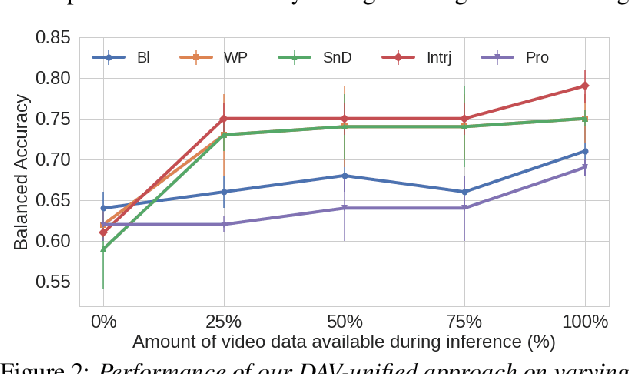Payal Mohapatra
Missingness-resilient Video-enhanced Multimodal Disfluency Detection
Jun 11, 2024


Abstract:Most existing speech disfluency detection techniques only rely upon acoustic data. In this work, we present a practical multimodal disfluency detection approach that leverages available video data together with audio. We curate an audiovisual dataset and propose a novel fusion technique with unified weight-sharing modality-agnostic encoders to learn the temporal and semantic context. Our resilient design accommodates real-world scenarios where the video modality may sometimes be missing during inference. We also present alternative fusion strategies when both modalities are assured to be complete. In experiments across five disfluency-detection tasks, our unified multimodal approach significantly outperforms Audio-only unimodal methods, yielding an average absolute improvement of 10% (i.e., 10 percentage point increase) when both video and audio modalities are always available, and 7% even when video modality is missing in half of the samples.
Phase-driven Domain Generalizable Learning for Nonstationary Time Series
Feb 05, 2024Abstract:Monitoring and recognizing patterns in continuous sensing data is crucial for many practical applications. These real-world time-series data are often nonstationary, characterized by varying statistical and spectral properties over time. This poses a significant challenge in developing learning models that can effectively generalize across different distributions. In this work, based on our observation that nonstationary statistics are intrinsically linked to the phase information, we propose a time-series learning framework, PhASER. It consists of three novel elements: 1) phase augmentation that diversifies non-stationarity while preserving discriminatory semantics, 2) separate feature encoding by viewing time-varying magnitude and phase as independent modalities, and 3) feature broadcasting by incorporating phase with a novel residual connection for inherent regularization to enhance distribution invariant learning. Upon extensive evaluation on 5 datasets from human activity recognition, sleep-stage classification, and gesture recognition against 10 state-of-the-art baseline methods, we demonstrate that PhASER consistently outperforms the best baselines by an average of 5% and up to 13% in some cases. Moreover, PhASER's principles can be applied broadly to boost the generalization ability of existing time series classification models.
Effect of Attention and Self-Supervised Speech Embeddings on Non-Semantic Speech Tasks
Aug 30, 2023



Abstract:Human emotion understanding is pivotal in making conversational technology mainstream. We view speech emotion understanding as a perception task which is a more realistic setting. With varying contexts (languages, demographics, etc.) different share of people perceive the same speech segment as a non-unanimous emotion. As part of the ACM Multimedia 2023 Computational Paralinguistics ChallengE (ComParE) in the EMotion Share track, we leverage their rich dataset of multilingual speakers and multi-label regression target of 'emotion share' or perception of that emotion. We demonstrate that the training scheme of different foundation models dictates their effectiveness for tasks beyond speech recognition, especially for non-semantic speech tasks like emotion understanding. This is a very complex task due to multilingual speakers, variability in the target labels, and inherent imbalance in the regression dataset. Our results show that HuBERT-Large with a self-attention-based light-weight sequence model provides 4.6% improvement over the reported baseline.
 Add to Chrome
Add to Chrome Add to Firefox
Add to Firefox Add to Edge
Add to Edge